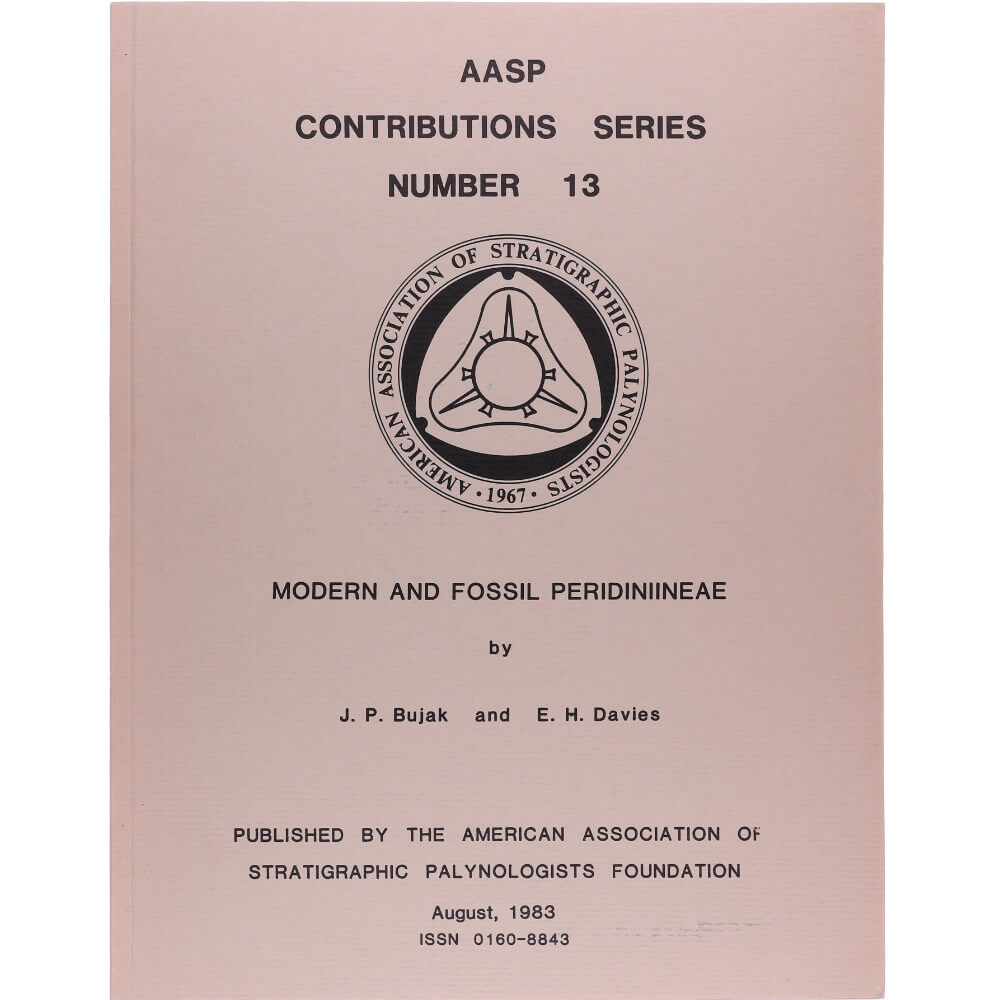Contributions Series Nr. 13
$4.00 – $5.00
Modern and Fossil Peridiniinae
J.P. Bujak & E.H. Davies
1983
PDF & Hardcopy available
218 pp.
Description
Abstract
The Suborder Peridiniineae of the Order Peridiniales comprises modern and fossil taxa that are characterized primarily by the presence of an anterior intercalary plate series. Modern genera are represented by the families Calciodinellaceae, Peridiniaceae and Protoperidiniaceae and taxa that appear to be extinct by the families Deflandreaceae and Peridinitaceae.
Modern marine taxa of the Family Protoperidiniaceae include Protoperidinium, Peridiniopsis and the Diplopsaloideae (Boreadinium, Diplopsalis, Diplopsalopsis, Dissodium, Oblea and Zygabikodinium). This family has variable epithecal and hypothecal tabulation, and mostly possesses three cingular plates plus a transitional cingular-sulcal plate. Cysts formed by this family are typically single-walled, composed of sporopollenin, often pigmented and form an intercalary archeopyle except in the Subfamily Diplopsaloideae.
Modern marine taxa of the Family Calciodinellaceae, which include the genera Ensiculifera and Scrippsiella, are characterized by an orthohexa tabulation style, the possession of four or five cingular plates plus a transitional cingular-sulcal plate, and the formation of calcareous cysts.
Modern freshwater taxa of the Family Peridiniaceae, which include Peridinium sensu stricto, have bipesioid and cinctioid tabulation styles, five or six cingular plates, and form capsulate sporopollenin cysts with multiplate archeopyles.
All of these families and a variety of extinct taxa are represented as fossils. The most abundant and diverse record in the Cretaceous-Paleogene comprises marine sporopollenin cysts of the family Deflandreaceae which had two walls and were often capsulate. Tabulation is raely shown by the cysts of the Deflandreaceae, but when delineated it is ortho-hexa 4’, 3a, 7”, 5c, 5”’, 2””, sometimes with a transitional cingular-sulcal plate, except in the ortho-quadra Subfamily Wetzielloideae and rare meta species of the genus Phthanoperidinium.
The origins of the Deflandreaceae are obscure, but the Early Cretaceous was an experimental period with various types of multiplate archeopyles being formed in the Subfamilies Ovoidinioideae, Palaeoperidinioideae and Subtilisphaeroideae. By the beginning of the Late Cretaceous, a hexa 1(2a) archeopyle was established in the Subfamily Deflandreoideae and this became the dominant type in the Late Cretaceous-Paleogene which was a period of specialization in I( 2a) archeopyle shape. During this period some taxa also evolved distinctive cyst shapes as seen in the Subfamily Palaeocystodinioideae which had a fusiform shape and the Subfamily Wetzelielloideae which had extended cingular horns. In some Late Cretaceous cysts the two walls became fused, as demonstrated by the Subfamily Senegalinioideae which had a wall structure intermediate between that of the Deflandreaceae and the Protoperidiniaceae.
Most marine cysts of the Deflandreaceae had become extinct by the Neogene, whereas single-walled cysts of the Protoperidiniaceae became increasingly important until today they have replaced the Deflandreaceae as the dominant cyst-forming Peridiniineae in the marine realm. Although cysts of the Protoperidiniaceae rarely show tabulation, it can be inferred that their evolution involved a reduction from five or six to three cingular plates and the development of a variable epithecal and hypothecal tabulation pattern, often with a reduced number of plates and an asymmetrical tabulation.
Modern freshwater Peridinium sensu stricto species of the Family Peridiniaceae are probably more closely related to extinct marine taxa of the Deflandreaceae than they are to modern marine species of the Protoperidiniaceae. This is indicated by the number of cingular plates that they possess, the symmetrical ortho-hexa bipesioid tabulation (4′ ,3a,7″,S”‘ ,2″”) in some species, and the formation of capsulate cysts with multiplate archeopyles. The Peridiniaceae show variations in the epithecal and hypothecal tabulation including a cinctioid tabulation style, but unlike the Protoperidiniaceae these variations often involve an increased number of plates. The Peridiniaceae are known only from the Cenozoic.
The Family Calciodinellaceae has a marine Late Jurassic to Recent fossil record of calcareous cysts that includes at least one genus of calcispheres. The symmetrical ortho-hexa tabulation of 4’ ,3a,7″ ,5″‘ ,2′”‘ has remained relatively stable since the Early Cretaceous, but the number of cingular plates has apparently been reduced from six plus a translational cingular-sulcal plate in the Hauterivian to a minimum of four plus a transitional plate in the modern genus Ensiculifera.
The Family Peridinitaceae comprises siliceous microfossils and is known only from the Paleogene. It has a well-delineated cinctioid tabulation, possibly with six cingular plates, and some specimens possess a precingular opening. It is uncertain whether these fossils represent the remains of thecae or cysts.
Based on these observations the supra-generic classifications of modern and fossil taxa of the Suborder Peridiniineae are amalgamated. Other taxonomic changes are minimized, but include several new combinations and the erection of the genus Manumiella .
